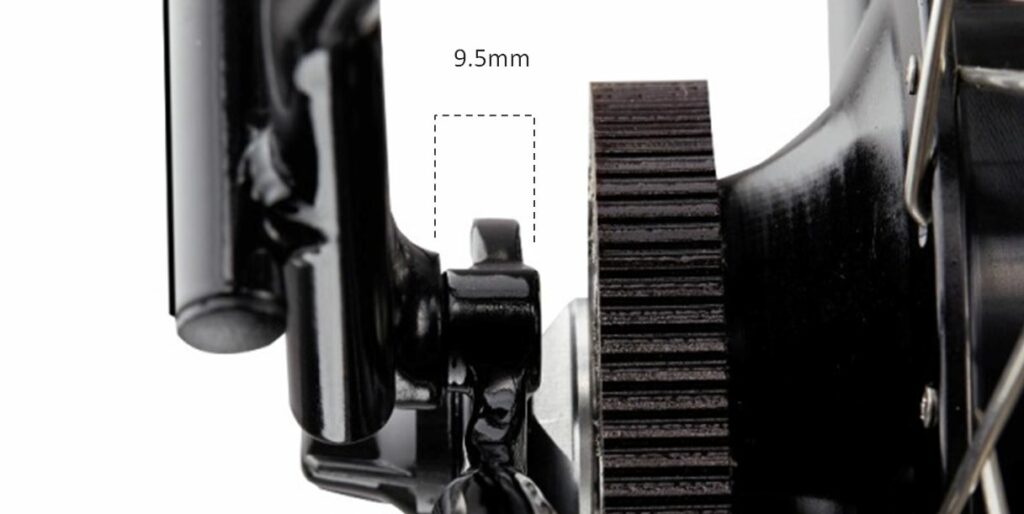Rider Height Range and Ease of Steering
Vivente touring bike designs suit people from 153cm to over 200cm.
By using a smaller wheel diameter on the XS size, the top-tube can be shorter without changing the frame head angle or the fork trail. That translates into not sacrificing the handling geometry.
The fork trail on all Vivente bikes sizes is above 60mm which makes the bikes particularly easy to steer. You don’t need to hold on so tightly which makes a noticeable difference if you are riding for hours.
BB (Bottom Bracket) Height
Relatively low bottom bracket heights also help make bikes comfortable. These are lower than what is typically found, for example, on competition bikes which includes cyclocross and mountain bikes. With a lower BB you are lower in relation to the wheels. A very different feeling compared to riding a small wheeled bike such as a folder. It is a little more like being “in” it than “on” it.
Rear Stays
464mm length chain-stays (436 on XS with the smaller wheels) leave a heel clearance gap from the panniers.
Chainstay Length
The distance between the rear axle and the crank axle is called chainstay length. Vivente has calculated that 464mm not only allows room for your heels to not hit pannier bags, but it allows for multiple combinations of sprockets and the best gear options on Rohloff-Gates systems.
Range of Tyre Widths
The positioning of the upper and lower bridges between the rear stays determines the maximum width of tyre that will fit. But, start with the question…what tyre width do you want?
On bikes with 32-44mm wide tyres, we recommend 700c wheels and use 46mm wide mudguards.
On bikes with 50-60mm tyres we recommend 650b wheels and 60mm wide mudguards.
Both easily fit in the frame and there is ample gap from the guards.
Mounts and Hardware
Mounts for the Tubus range of front racks are fitted to the forks. These are independent of the front mudguard stay-mounts.
There are spare spoke mounts on the left side seat-stay. Also, on the seat-stays, near the upper bridge are mounts for the traditional type of frame lock.
At the rear of the fork crown and under the downtube are mounts for a steering stabilizer which is good when using front panniers, when on longer rides and for parking.
Regular frames have three water bottle mounts. DTT frames have two. (Two are an extra two on the front forks).
BSA and EBB Frame Types
Birmingham Small Arms (BSA) and Eccentric Bottom Bracket (EBB) are two types of bottom bracket shells in bike frames. Almost all frames are BSA which is a reference to the thread dimensions that the bottom bracket unit screws into.
When a bike has just one sprocket at the front and one at the rear, there needs to be a way of tensioning the chain or belt. This can be done at either end.
Vivente does it at the bottom bracket end. The BB “shell” in the frame is larger, allowing an EBB unit to be inserted. This unit is larger than the bottom bracket unit itself. It is inserted into the shell, is able to rotate, and be “locked” in place when the belt tension is correct.
The method of locking is with internal wedges that slide on ramps. These are well greased in bike production and should be regreased if ever removed.
Break in the Frame for Belt Installation
To install a belt, the frame needs a break somewhere because, unlike a bike chain which can be broken and rejoined, a belt cannot be. Vivente has its break midway along the right-side seat stay.
Rear Rack Attachment
Decades of refinement have been needed to arrive at the modern Vivente frames. A regular supply of new test frames and several tours per year have resulted in the latest product available today.
The geometry has barely changed in 30 years but many smaller details have. One example of such a change has been a new casting of the rear dropouts so that there is now 9.5mm of metal (rather than the conventional 7.0mm) into which the lower rack attachment screws are fitted.

We were aware that the normal length screws, on rough roads and tracks, would sometimes come loose. If not checked, this allowed the screws to move sideways and damage the threads in the frame with possible disastrous results. Even if this happened only on one in a thousand bikes it is what we need to prevent.